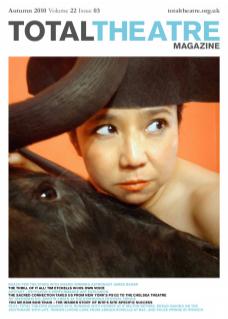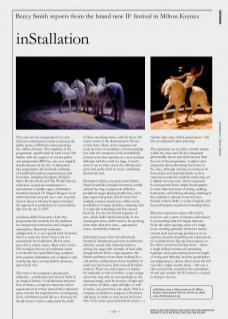This year saw the inauguration of a new festival of international work colonising the public spaces of Britain’s fastest growing city, Milton Keynes. The emphasis of the programme, spearheaded by local venue The Stables with the support of veteran public arts programmer Bill Gee, was on a magical transformation of the city. A substantial free programme that featured a melange of established outdoor experimenters and favourites, including Kompany Malakhi, Metro Boulot Dodo and The World Famous, reflected a curatorial commitment to reinventions of public space (Artichoke’s beautiful carousel The Magical Menagerie in an industrial-scale car-park was a case in point). Artistic director Monica Ferguson defined the approach as producing ten extraordinary days for the city in 2010.
inStallation didn’t form part of the free programme but certainly hit the ambition for unexpected reinvention and a magical atmosphere. Described somewhat ambiguously as ‘a very special kind of theatre’ there’s a sense the show’s been a bit of a conundrum for marketeers. But in many ways this is classic circus, albeit with a twist. The nostalgic flavour of traditional circus is evoked by the sand-filled ring, complete with pendant chandeliers; the company’s own touring big top; a strong diabolo presence; and animal acts.
The twist is the company’s unexpected collective – combining their diverse skills in an original format. A collaboration between four acrobats, a composer-musician and an equestrian artist whose shared Swiss rehearsal space formed the inspiration for an intriguing show, inStallation started life as a showcase for friends keen to better understand the skills of these travelling artists, and the show still retains some of the demonstrative flavour of this form. Many of the sequences are tours de force of acrobatics or horsemanship but, with the exception of the wonderfully eclectic score that operates as a near constant dialogue with the work on stage, it wasn’t clear to me to what extent the collaborative parts had really fused to create something theatrically new.
Performers climb over guest artist Stefan Hegi’s beautifully designed doorway, tumble around the ring or appear on different peripheral stages playing double bass, mini pipe organ and guitar, and it’s clear that multiple creative minds have riffed on the possibilities of space and idea, tinkering with it to provide something that best served them all. For me, the linked sequence of acts, which didn’t build narratively in any meaningful sense, didn’t need to be anything more than what they were – spectacular circus, beautifully rendered.
Individual scenes often felt effortlessly theatrical. Imaginative gestures transformed effective scenes with theatrical artistry: exiting the stage with a bundle of back silks dropped down from a rope sequence, the female performer wears them trailing like a veil and her collaborators throw handfuls of sand over her head as their mournful bride’s confetti. There was real respect on display for materials as well as bodies: a rope swings across the ring with its own spotlight as the opening image, and the textures, weight and movement of fabric, sand and light, as well as music, are given their own space. This is a company confident to compose with silence and space as much as with action and noise. One of the most successful diabolo scenes – a frenetic duet atop a black grand piano – felt like an animated Cubist painting.
The equestrian art sat with a certain unease within the show and felt less integrated (presumably due to practical reasons) than the rest of the programme. A rather stern injunction about disturbing the horses at the start, although making us conscious of their power and unpredictability as they cantered around the suddenly small ring, set a slightly nervous tone. Horse sequences that progressed from simple choreography to more elaborate feats of sitting, walking backwards, and hind-leg dancing, challenged the audience’s cultural mores but were limited in their ability to really integrate with the performance material surrounding them.
What the equestrian scenes did exult in, however, was a sense of mystery and majesty to proceedings that felt fragile and rare. From the silent opening scene of a single horse standing patiently whilst her master sweeps sand centre-stage greeting us as we entered, instantly dispelling any expectations of a rambunctious big top extravaganza, to the show’s powerful closing scene – where a single diabolo mimics the preceding tightrope act by pirouetting down its length of string and ‘dancing’ atop the grand piano accompanying it, closely observed by the full cast and a single sombre horse – this was a show powerfully steeped in the atmosphere of awe and wonder the IF festival so wanted to bring to the city.
inStallation was a UK premiere at IF: Milton Keynes International Festival 16-25 July 2010. www.ifmiltonkeynes.org

